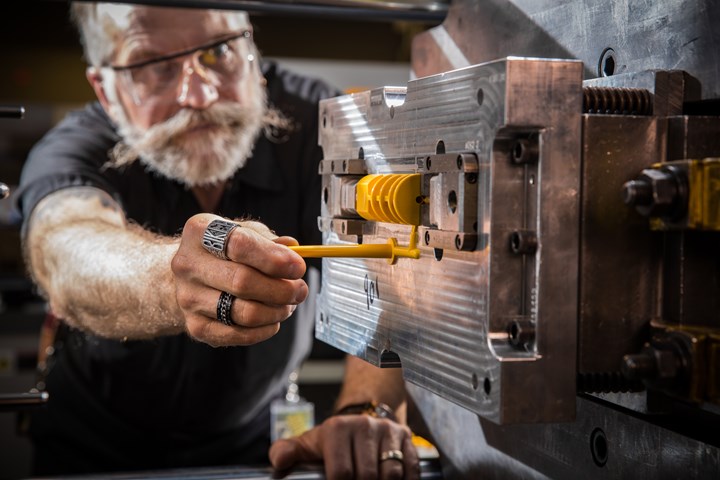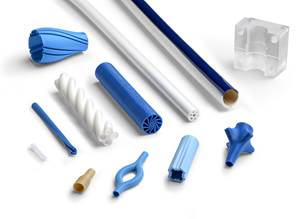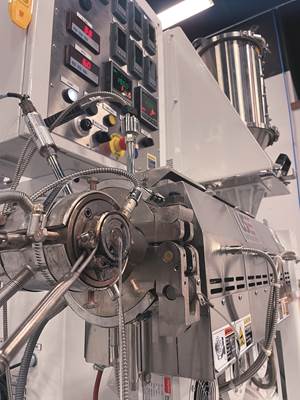Protolabs Addresses How to Survive a Pandemic with Digital Manufacturing
Protolabs survey results examine product development and the supply chain.
A new trend report, Product Development and the Supply Chain—How to Survive a Pandemic with Digital Manufacturing, was recently unveiled by global supplier of rapid injection molding prototyping and short-run on-demand manufacturing Protolabs, Maple Plain, Minn.

Recognizing that COVID-19 has disrupted business for all industries Protolabs serves, the company sought to better get a handle on their customers’ experience and outlook in the face of this crisis by conducting a survey of 108 customers across 12 industries between June and July 2020. Insight from designers, engineers, and supply chain managers enabled Protolabs to evaluate how their customers can use digital manufacturing to not only survive this crisis, but thrive in the future.
Protolabs’ customer survey report highlights how the pandemic has exposed weaknesses in the supply chain. Included is that a whopping 74% of respondents say that supplier delays caused by COVID have impacted their business. Other key highlights:
▪ More than half of respondents have faced supply chain risks since the start of the pandemic.
▪ More than half say the work-from-home has hurt productivity, pointing to the lack of adequate access to tools as a major factor.
▪ More than 80% believe innovation and new product development will pick up before year’s end.
According to the Protolabs survey, COVID-19 exposed the need for manufacturing to shore up resources now, but the companies that thrive in the future will take lessons learned during this crisis to build agile, resilient and modern supply chains that spur innovation. Protolabs sees digital manufacturing as the way to provide the critical speed and flexibility.

As noted by the report: The traditional supply chain was about pricing and globalization—find the cheapest parts wherever they could be sourced from. In recent history—and a trend that COVID-19 has accelerated—manufacturers are inventing in Industry 4.0, relying on digital manufacturing and agile supply chains to protect themselves from volatility. The Protolabs report offers a few COVID-1 lessons for building the supply chain of the future, including:
▪ Plan to adapt for changing conditions.
COVID-19 proved to many manufacturers that their crisis and contingency plans were not adequate. For future planning, do deep research into your supply chain and examine even tier 3 suppliers for potential weaknesses. Make sure that there are easily accessible alternatives. Build more local suppliers into your plan. Plan foroperating to maximize cash flow rather than profits in the short term and review your company’s product portfolio and customer base in order to set priorities.
▪ A global network with a foundation of regional suppliers.
Using regional suppliers can be an effective way for companies to dodge global disruptions, especially if those regional suppliers also use regional suppliers. Many companies have been discovering the benefits of onshoring options, taking advantage of contract manufacturers that use digital technologies on their own shores and insulating their companies from macro-economic unpredictability. At Protolabs, we’re seeing an increasing number of our customers turning to localized and on-demand manufacturing as alternatives to off-shoring. Manufacturing locally, or closer to the point of consumption, has been made more economically feasible with the proliferation of digital manufacturing
▪ On-demand production can tame demand volatility.
On-demand manufacturing can help companies tame demand volatility, gain greater control of inventory cost, and deliver the right products at the right time at the right total cost. Manufacturing on demand helps companies navigate market volatility so that they’re not tied to massive production forecasts. When demand spikes, parts can be produced quickly. On-demand sourcing can also lower overall inventory costs and warehousing expenses because there’s no longer a focus on mass producing products with high minimum order quantities (MOQs).Instead, opting for on-demand production in low volumes creates a supply chain that is truly driven by customer demand, not by (and dependent on) a supplier’s lead time.
▪ Mass customizations support supply chains.
Another way to tame supply chain disruption is to deploy a mass customization approach. Today’s market demands are more customized. This low-volume and high-mix ratio of products is not the supply chain of the past where mass production was the normal way of doing business. Indeed, customization is changing how manufacturing needs to react and on-demand manufacturing has the digital capacity and rapid capability to meet thosemass customization needs.
▪ Reliable, fast lead times aid supply chains.
Acting quickly can help minimize disruptions. Accordingly, turning to a digital manufacturer that can pair manufacturing scale with reliable, fast lead times enables companies to quickly adapt to market demands and unforeseen forces in supply chains. Indeed, under a fully digitized process, accurate price quotes can be provided in hours, if not instantly, and the manufacturing can be completed often in a matter of days, sometimes even the same day. This speed can make a difference especially when you factor in the total cost of ownership all along the supply chain, from concept to distribution. For example, if a product is sitting on a container ship for three months, well, that’s all a part of your total cost. This kind of agility makes the pivoting that was necessary for many companies during COVID-19 possible.
Related Content
DuPont Buys Medical Product Manufacturer Spectrum Plastics
Purchase price of $1.75 billion for leading supplier of extruded, molded, and 3D printed medical components.
Read MoreWhat to Look for in High-Speed Automation for Pipette Production
Automation is a must-have for molders of pipettes. Make sure your supplier provides assurances of throughput and output, manpower utilization, floor space consumption and payback period.
Read MoreMedical Tubing: Use Simulation to Troubleshoot, Optimize Processing & Dies
Extrusion simulations can be useful in anticipating issues and running “what-if” scenarios to size extruders and design dies for extrusion projects. It should be used at early stages of any project to avoid trial and error and remaking tooling.
Read MoreCatheter Specialist Finds Sweet Spot Serving Small, Medium-Sized Concerns
Medical-component specialist LightningCath has carved a niche meeting the needs of small to medium-sized entrepreneurs with complex catheter designs … quickly.
Read MoreRead Next
See Recyclers Close the Loop on Trade Show Production Scrap at NPE2024
A collaboration between show organizer PLASTICS, recycler CPR and size reduction experts WEIMA and Conair recovered and recycled all production scrap at NPE2024.
Read MoreBeyond Prototypes: 8 Ways the Plastics Industry Is Using 3D Printing
Plastics processors are finding applications for 3D printing around the plant and across the supply chain. Here are 8 examples to look for at NPE2024.
Read More













